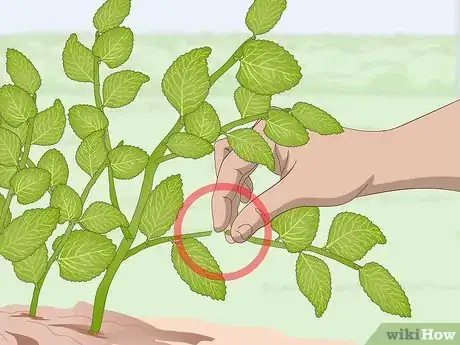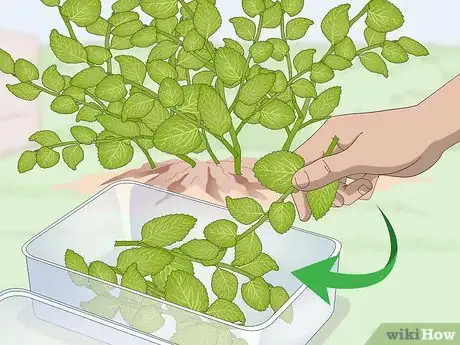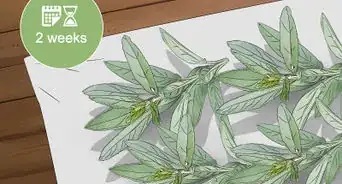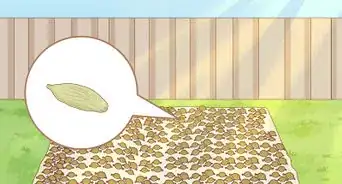X
This article was co-authored by Maggie Moran and by wikiHow staff writer, Danielle Blinka, MA, MPA. Maggie Moran is a Professional Gardener in Pennsylvania.
This article has been viewed 57,694 times.
Oregano is a tasty herb that's a perfect choice for any herb garden. When growing oregano, it's important to prune it, as this ensures that the plant thrives. During the spring and summer growing season, you'll want to prune your oregano often to encourage new growth. Once the growing season is over, you'll need to remove the dead flowers and stems. If you want to eat your oregano, you can also harvest it.
Steps
Method 1
Method 1 of 3:
Caring for Oregano During Growing Season
-
1Wait until your plant is at least 4 inches (10 cm) tall. Trimming the plant too early could cause your plant to fail to thrive, so be patient. Luckily, oregano usually grows quickly.[1]
- Pruning your oregano will encourage new growth. Not only will it grow more leaves, it'll even grow more stems!
-
2Cut back no more than 1/3rd of the plant at a time. This prevents over-pruning. If you cut away too much of the plant at once, your plant may not survive.[2]
- Before pruning your oregano again, make sure it's grown back to at least 4 inches (10 cm) tall.
Advertisement -
3Cut the stems when you need to remove several at once. Place a pair of scissors or small pruning shears against the stem above the leaves where you plan to make your cut. Then, make a clean cut to remove the stalk.[3]
- You may try to cut several stems at once, depending on the size of your plant. It's best if you cut just 1 stalk at a time.
-
4Pinch off the stems for easy pruning. Pinching is a quick, easy way to prune your herbs.[4] Place your fingers on the stem just above the leaves, then use your fingernails to pinch off the stem.[5]
- It helps to hold the base of the stem with your other hand to avoid damaging the rest of the stalk.
- This is a great option for removing 1 or 2 stems at a time.
-
5Set the stalks aside while you continue pruning. If you plan to use them in your kitchen, you should place them in a clean, dry container.[6]
- Continue to cut until you've trimmed all of the stems you'd like to prune.
- If the removed stems are still green, you can use them in your kitchen! However, dead stems should be composted or thrown away.
Advertisement
Method 2
Method 2 of 3:
Tending to Dormant Oregano
-
1Deadhead the flowers after they fade at the end of summer. This allows the plant to direct its nutrients toward new growth instead of seeding. Using scissors or pruning shears, cut just below the flowers. You can also trim further down the stem, as long as you don't cut more than ⅓ of the stalk.
- As an alternative, you can deadhead the flowers by simply pinching off the old flower. This works better if the flower is dead or dying.[7]
-
2Stop pruning at least 2 weeks before cold weather is forecast. Your plant will be vulnerable during cold weather, so it's a good idea to stop pruning it before winter comes. This increases the likelihood that it will survive winter![8]
- If you want to use your oregano during winter, it's best to rely on dried herbs that you've stored.
-
3Remove dead stems during the winter. Wait until late winter to prepare the oregano for regrowth in the spring. Look for stems that are dry, brown, and lack leaves. Trim them down to the base of the plant, just above the roots.[9]
- You can use scissors or small pruning shears.
-
4Add an organic liquid fertilizer to the oregano. This will provide it with extra nutrients to help it go into the next growing season. For best results, mix the fertilizer into water and pour it over the plant at its next watering.[10]
- Be sure to follow the label to ensure that you provide the right amount of fertilizer.
- You can find a liquid fertilizer at your local gardening store or online.
Advertisement
Method 3
Method 3 of 3:
Harvesting Oregano
-
1Harvest oregano just before the plant flowers, or as needed. Oregano is most flavorful right before the plant flowers, so this is the perfect time to harvest if you plan to dry or freeze your herbs. However, you can also harvest small amounts of oregano to use fresh in your kitchen.[11]
- Keep in mind that the oregano may taste bitter after the plant flowers, so it's a good idea to harvest the remaining stems before your plant flowers. You can dry them by hanging them in bunches or using a dehydrator. Alternatively, you could freeze them.
- The best time to harvest oregano is in the morning after the dew dries.
- The flavor of your oregano will be strongest during warm weather.
-
2Place your scissors 1/3rd of the way down a stem of oregano. You can harvest less, but not more. Position the scissors against the stem in a spot that's in between the leaves to prevent damaging the leaves.[12]
-
3Run your fingers along the stem to remove just the leaves if you prefer. Place your thumb and middle finger just below the leaves you want to harvest. Slowly run your hand up the stem to pull off the leaves, collecting them as you go. Place the leaves in a clean, dry container for use in your kitchen.
- Cut away the bare stem using your scissors.[13]
- This is a great alternative for days when you just want a few leaves to season a dish.
Advertisement
Expert Q&A
Did you know you can get expert answers for this article?
Unlock expert answers by supporting wikiHow
-
QuestionCan you harvest oregano after it flowers?
 Maggie MoranMaggie Moran is a Professional Gardener in Pennsylvania.
Maggie MoranMaggie Moran is a Professional Gardener in Pennsylvania.
Home & Garden Specialist
-
QuestionWhen should you cut back sage?
 Maggie MoranMaggie Moran is a Professional Gardener in Pennsylvania.
Maggie MoranMaggie Moran is a Professional Gardener in Pennsylvania.
Home & Garden Specialist
-
QuestionHow often do you water oregano?
 Maggie MoranMaggie Moran is a Professional Gardener in Pennsylvania.
Maggie MoranMaggie Moran is a Professional Gardener in Pennsylvania.
Home & Garden Specialist
Advertisement
Things You'll Need
- Scissors or small pruning shears
- Liquid fertilizer
- Water
- Watering can or container
- Clean, dry food container (optional)
- Food dehydrator (optional)
References
- ↑ https://www.almanac.com/plant/oregano
- ↑ https://www.thekitchn.com/everything-you-need-to-know-about-growing-oregano-220612
- ↑ https://www.thekitchn.com/everything-you-need-to-know-about-growing-oregano-220612
- ↑ https://www.almanac.com/plant/oregano
- ↑ https://davesgarden.com/guides/articles/view/106
- ↑ https://www.thekitchn.com/everything-you-need-to-know-about-growing-oregano-220612
- ↑ https://www.rhs.org.uk/advice/grow-your-own/herbs/oregano
- ↑ https://davesgarden.com/guides/articles/view/106
- ↑ https://www.rhs.org.uk/advice/grow-your-own/herbs/oregano
- ↑ https://www.rhs.org.uk/advice/grow-your-own/herbs/oregano
- ↑ https://www.thekitchn.com/everything-you-need-to-know-about-growing-oregano-220612
- ↑ https://www.thekitchn.com/everything-you-need-to-know-about-growing-oregano-220612
- ↑ https://www.thekitchn.com/everything-you-need-to-know-about-growing-oregano-220612
About This Article
Advertisement









































































